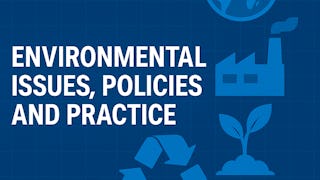Environmental economics is a powerful and comprehensive approach to understanding, assessing, and addressing the world’s most pressing environmental and sustainability challenges. This course, “Environmental Economics,” provides training in the principles, conceptual frameworks, and applications of environmental economics.
通过 Coursera Plus 解锁访问 10,000 多门课程。开始 7 天免费试用。


您将学到什么
Understand key concepts like market failures and externalities in relation to the environment
Learn how environmental economics is used to create and evaluate sustainability policies
Explore methods of valuing environmental goods and services that are not typically sold in markets
Learn economic approaches to assessing the global transition to renewable energy and climate policies aimed at limiting global temperature increases
您将获得的技能
- Sustainable Development
- Public Policies
- Cost Benefit Analysis
- Climate Change Mitigation
- Oil and Gas
- Sustainable Business
- Economics
- Market Dynamics
- Environmental Policy
- Environmental Social And Corporate Governance (ESG)
- Environmental Resource Management
- Environmental Regulations
- Natural Resource Management
- Policy Analysis
- Decision Making
要了解的详细信息

添加到您的领英档案
19 项作业
了解顶级公司的员工如何掌握热门技能

积累特定领域的专业知识
- 向行业专家学习新概念
- 获得对主题或工具的基础理解
- 通过实践项目培养工作相关技能
- 获得可共享的职业证书

该课程共有7个模块
Pollution externalities are widespread in modern industrial economies. In microeconomics, an externality is a key defect of a market and creates the rationale for government intervention in the economy. This first module provides an overview of the field of Environmental Economics and reviews the essential microeconomic principles for the course.
涵盖的内容
6个视频5篇阅读材料2个作业1个讨论话题
Concepts and methods are needed for quantifying the economic value of goods and services not transacted in markets. “Nature’s services” are a prime example of these. These methods, and their application, are an important sub-field of environmental economics, with relevance to public policy and government programs.
涵盖的内容
5个视频2篇阅读材料3个作业
Environmental regulation typically involves a public policy that requires companies to reduce emissions of one or more pollutants. Market-based policy instruments are defined by providing financial incentives for companies to reduce emissions, instead of prescribing particular reductions. They have the virtue of cost-effectiveness, that is, of achieving least-cost compliance with the regulation. This module uses the example of carbon dioxide (CO2) emissions as the regulated pollutant.
涵盖的内容
7个视频1篇阅读材料3个作业
The economic benefits and/or costs of a prospective policy or program can occur at different times in the future. Discounting is an approach for translating future dollar values into a consistent metric, present-value dollars. Discounting plays an important role in quantifying the Social Cost of Carbon – a key concept in the economics of climate policy. The material in this module builds a bridge to the next module on benefit-cost analysis.
涵盖的内容
4个视频1篇阅读材料2个作业
Benefit-cost analysis (abbreviated as BCA) is the standard economic framework for evaluating a public policy or government program. It involves enumerating the various categories of benefits and costs of a policy and, where possible, quantitatively estimating those benefits and costs. An example is provided of the BCA conducted for the first major climate policy in the United States: greenhouse gas emissions standards for automobiles, which was finalized in 2012.
涵盖的内容
4个视频2篇阅读材料3个作业
Transitioning from fossil fuel to renewable energy resources is a critical issue of global sustainability. This transition is inherently an intertemporal problem: the global economy depletes the physical stock of fossil fuel over time before transitioning to renewable resources such as solar and wind. We develop the conceptual framework used in economics to understand the problem. An empirical application of the framework demonstrates the key economic logic: the economy transitions to renewable energy when renewables are cost-competitive with fossil fuel.
涵盖的内容
5个视频1篇阅读材料3个作业
The amount of carbon dioxide in Earth’s atmosphere is a second resource stock (in reference to Module 6’s stock of fossil fuel). The carbon budget is a common way to express this stock: beginning now, how much carbon dioxide can be emitted into the atmosphere before a particular climate policy target is reached? We build on the conceptual framework of Module 6 to consider a carbon budget as an expression of global climate policy. We then consider a benefit-cost analytic approach to assessing climate policy options. We understand both elements of, and results from, the analysis.
涵盖的内容
5个视频2篇阅读材料3个作业
获得职业证书
将此证书添加到您的 LinkedIn 个人资料、简历或履历中。在社交媒体和绩效考核中分享。
位教师

从 Economics 浏览更多内容
 状态:预览
状态:预览Erasmus University Rotterdam
 状态:免费试用
状态:免费试用EDHEC Business School
 状态:预览
状态:预览O.P. Jindal Global University
 状态:预览
状态:预览University of Western Australia
人们为什么选择 Coursera 来帮助自己实现职业发展




学生评论
22 条评论
- 5 stars
81.81%
- 4 stars
18.18%
- 3 stars
0%
- 2 stars
0%
- 1 star
0%
显示 3/22 个
已于 Oct 11, 2025审阅
The course is very helpful in environmental economics. It also demonstrates the different methods used in economics. Thank you.
常见问题
To access the course materials, assignments and to earn a Certificate, you will need to purchase the Certificate experience when you enroll in a course. You can try a Free Trial instead, or apply for Financial Aid. The course may offer 'Full Course, No Certificate' instead. This option lets you see all course materials, submit required assessments, and get a final grade. This also means that you will not be able to purchase a Certificate experience.
When you enroll in the course, you get access to all of the courses in the Specialization, and you earn a certificate when you complete the work. Your electronic Certificate will be added to your Accomplishments page - from there, you can print your Certificate or add it to your LinkedIn profile.
Yes. In select learning programs, you can apply for financial aid or a scholarship if you can’t afford the enrollment fee. If fin aid or scholarship is available for your learning program selection, you’ll find a link to apply on the description page.
更多问题
提供助学金,



